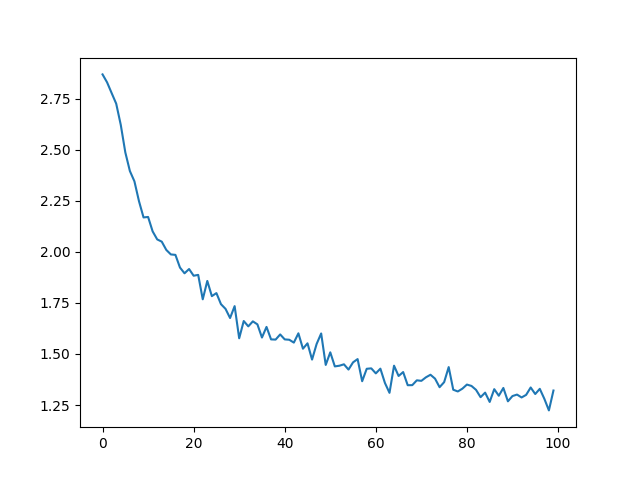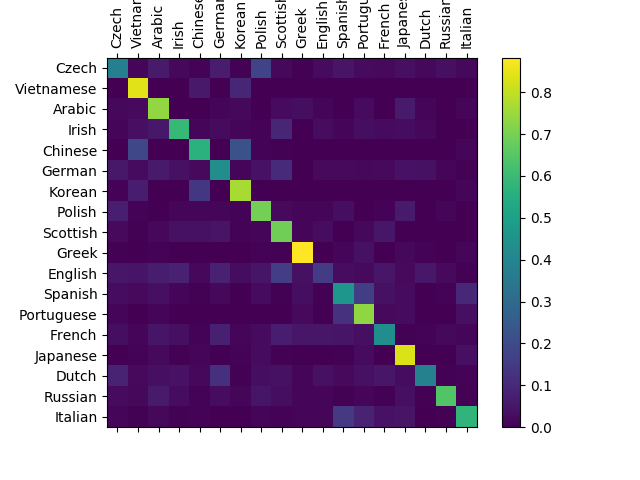注意
here下载完整的示例代码
从零开始 NLP:使用字符级 RNN 分类名字¶
我们将建立和训练一个基本的字符级 RNN 来分类单词。 本教程以及以下两个教程演示如何"从零开始"为 NLP 建模做数据预处理,特别的是不使用 torchtext 的许多便捷函数,因此你可以看到 NLP 建模的预处理在底层如何工作。
字符级 RNN 将单词作为一系列字符读取 — 在每个步骤中输出预测和"隐藏状态"并将前一个隐藏状态输入到下一个步骤。 我们把最终的预测作为输出,即单词属于哪个类别。
具体来说,我们将对来自18种语言的几千个姓氏进行训练,并根据拼写预测名字来自哪种语言:
$ python predict.py Hinton
(-0.47) Scottish
(-1.52) English
(-3.57) Irish
$ python predict.py Schmidhuber
(-0.19) German
(-2.48) Czech
(-2.68) Dutch
推荐阅读:
我假设你至少安装了 PyTorch,知道 Python 并理解 Tensor:
安装指南: https://pytorch.org/
PyTorch 入门: PyTorch 深度学习:60分钟闪电战
根据示例学习 PyTorch 提供广泛而深入的概述
如果你之前 Lua Torch 用户,请参考 PyTorch for Former Torch Users
了解 RNN 及其工作方式也很有用:
循环神经网络的异常有效性 展示一系列真实生活的例子
了解 LSTM 网络 是专门介绍 LSTM 的,但也有关于 RNN 的一般信息
准备数据¶
注意
从此处下载数据并将其提取到当前目录。
data/names目录中包含 18 个文本文件,这些文件名为“[Language].txt”。 每个文件包含一组名字,每行一个名字,大部分是罗马字母化的(但我们仍然需要从 Unicode 转换为 ASCII)。
最后,我们将得到每种语言的一个名字列表字典,
{language: [names ...]}。 变量"category"和"line"(在我们的例子中用于语言和名字)用于以后的扩展。
from __future__ import unicode_literals, print_function, division
from io import open
import glob
import os
def findFiles(path): return glob.glob(path)
print(findFiles('data/names/*.txt'))
import unicodedata
import string
all_letters = string.ascii_letters + " .,;'"
n_letters = len(all_letters)
# Turn a Unicode string to plain ASCII, thanks to https://stackoverflow.com/a/518232/2809427
def unicodeToAscii(s):
return ''.join(
c for c in unicodedata.normalize('NFD', s)
if unicodedata.category(c) != 'Mn'
and c in all_letters
)
print(unicodeToAscii('Ślusàrski'))
# Build the category_lines dictionary, a list of names per language
category_lines = {}
all_categories = []
# Read a file and split into lines
def readLines(filename):
lines = open(filename, encoding='utf-8').read().strip().split('\n')
return [unicodeToAscii(line) for line in lines]
for filename in findFiles('data/names/*.txt'):
category = os.path.splitext(os.path.basename(filename))[0]
all_categories.append(category)
lines = readLines(filename)
category_lines[category] = lines
n_categories = len(all_categories)
输出:
['data/names/Czech.txt', 'data/names/Vietnamese.txt', 'data/names/Arabic.txt', 'data/names/Irish.txt', 'data/names/Chinese.txt', 'data/names/German.txt', 'data/names/Korean.txt', 'data/names/Polish.txt', 'data/names/Scottish.txt', 'data/names/Greek.txt', 'data/names/English.txt', 'data/names/Spanish.txt', 'data/names/Portuguese.txt', 'data/names/French.txt', 'data/names/Japanese.txt', 'data/names/Dutch.txt', 'data/names/Russian.txt', 'data/names/Italian.txt']
Slusarski
现在我们有了category_lines一个字典将每个类别(语言)映射到行(名称)列表。 我们还跟踪all_categories(只是语言列表)和n_categories供以后参考。
print(category_lines['Italian'][:5])
输出:
['Abandonato', 'Abatangelo', 'Abatantuono', 'Abate', 'Abategiovanni']
将名字转换为张量¶
现在,我们已经组织好所有的名字,我们需要把它们变成张量,以充分利用它们。
为了表示单个字母,我们使用大小为<1 x n_letters>的“one-hot 向量”。 一个 one-hot 向量除当前字母索引处的数字为 1,其余用 0 填充,例如"b" = <0 1 0 0 0 ...>。
为了成为一个词,我们将它们连接成一个 2D 矩阵<line_length x 1 x n_letters>。
额外的 1 维度是因为 PyTorch 假定一切都是分批次的 — 我们这里只使用大小为 1 的批处理。
import torch
# Find letter index from all_letters, e.g. "a" = 0
def letterToIndex(letter):
return all_letters.find(letter)
# Just for demonstration, turn a letter into a <1 x n_letters> Tensor
def letterToTensor(letter):
tensor = torch.zeros(1, n_letters)
tensor[0][letterToIndex(letter)] = 1
return tensor
# Turn a line into a <line_length x 1 x n_letters>,
# or an array of one-hot letter vectors
def lineToTensor(line):
tensor = torch.zeros(len(line), 1, n_letters)
for li, letter in enumerate(line):
tensor[li][0][letterToIndex(letter)] = 1
return tensor
print(letterToTensor('J'))
print(lineToTensor('Jones').size())
输出:
tensor([[0., 0., 0., 0., 0., 0., 0., 0., 0., 0., 0., 0., 0., 0., 0., 0., 0., 0.,
0., 0., 0., 0., 0., 0., 0., 0., 0., 0., 0., 0., 0., 0., 0., 0., 0., 1.,
0., 0., 0., 0., 0., 0., 0., 0., 0., 0., 0., 0., 0., 0., 0., 0., 0., 0.,
0., 0., 0.]])
torch.Size([5, 1, 57])
创建网络¶
在自动分级之前,在 Torch 中创建循环神经网络涉及在几个时间步长内克隆层的参数。 保持隐藏状态和渐变的图层现在完全由图形本身处理。 这意味着您可以以非常"纯"的方式实现 RNN,作为常规进给层。
此 RNN 模块(主要从用于割炬用户的 PyTorch 用户教程复制)只是 2 个线性图层,它们在输入和隐藏状态上运行,输出后有一个 LogSoftmax 图层。

import torch.nn as nn
class RNN(nn.Module):
def __init__(self, input_size, hidden_size, output_size):
super(RNN, self).__init__()
self.hidden_size = hidden_size
self.i2h = nn.Linear(input_size + hidden_size, hidden_size)
self.i2o = nn.Linear(input_size + hidden_size, output_size)
self.softmax = nn.LogSoftmax(dim=1)
def forward(self, input, hidden):
combined = torch.cat((input, hidden), 1)
hidden = self.i2h(combined)
output = self.i2o(combined)
output = self.softmax(output)
return output, hidden
def initHidden(self):
return torch.zeros(1, self.hidden_size)
n_hidden = 128
rnn = RNN(n_letters, n_hidden, n_categories)
要运行此网络的一个步骤,我们需要传递一个输入(在我们的例子中,当前字母的 Tensor)和以前的隐藏状态(我们首先初始化为零)。 我们将返回输出(每种语言的概率)和下一个隐藏状态(我们为下一步保留该状态)。
input = letterToTensor('A')
hidden =torch.zeros(1, n_hidden)
output, next_hidden = rnn(input, hidden)
为了提高效率,我们不想为每个步骤创建新的"张力",因此我们将使用lineToTensor而不是letterToTensor并使用切片。 这可以通过预计算的张量进一步优化。
input = lineToTensor('Albert')
hidden = torch.zeros(1, n_hidden)
output, next_hidden = rnn(input[0], hidden)
print(output)
输出:
tensor([[-2.9094, -2.9352, -2.9637, -2.9170, -2.9943, -2.7928, -2.9661, -2.9507,
-2.7908, -2.8993, -2.8857, -2.8203, -2.8707, -2.9812, -2.8445, -2.8495,
-2.8213, -2.8694]], grad_fn=<LogSoftmaxBackward>)
正如您所看到的,输出是<1 x n_categories> Tensor,其中每个项目都是该类别的可能性(越可能越高)。
训练¶
准备训练¶
在开始训练之前,我们应该做一些辅助函数。 第一种是解释网络的输出,我们知道每个类别的可能性。 我们可以使用Tensor.topk来获取最大值的索引:
def categoryFromOutput(output):
top_n, top_i = output.topk(1)
category_i = top_i[0].item()
return all_categories[category_i], category_i
print(categoryFromOutput(output))
输出:
('Scottish', 8)
我们还希望快速获得训练示例(姓名及其语言):
import random
def randomChoice(l):
return l[random.randint(0, len(l) - 1)]
def randomTrainingExample():
category = randomChoice(all_categories)
line = randomChoice(category_lines[category])
category_tensor = torch.tensor([all_categories.index(category)], dtype=torch.long)
line_tensor = lineToTensor(line)
return category, line, category_tensor, line_tensor
for i in range(10):
category, line, category_tensor, line_tensor = randomTrainingExample()
print('category =', category, '/ line =', line)
输出:
category = Russian / line = Hazov
category = Scottish / line = Fraser
category = German / line = Stieber
category = Greek / line = Close
category = Italian / line = Ruggeri
category = Polish / line = Gorka
category = Arabic / line = Antar
category = Polish / line = Sokal
category = Vietnamese / line = Doan
category = Czech / line = Fritsch
训练网络¶
现在,训练这个网络所需要的只是向它展示一堆例子,让它做出猜测,并告诉它,如果它是错的。
对于损失函数,nn.NLLLoss是正确的,因为 RNN 的最后一层是nn.LogSoftmax。
criterion = nn.NLLLoss()
每个训练循环将:
创建输入和目标张量
创建值为零的初始隐藏状态
读取每个字母并
为下一个字母保留隐藏状态
将最终输出与目标进行比较
反回传播
返回输出和损失
learning_rate = 0.005 # If you set this too high, it might explode. If too low, it might not learn
def train(category_tensor, line_tensor):
hidden = rnn.initHidden()
rnn.zero_grad()
for i in range(line_tensor.size()[0]):
output, hidden = rnn(line_tensor[i], hidden)
loss = criterion(output, category_tensor)
loss.backward()
# Add parameters' gradients to their values, multiplied by learning rate
for p in rnn.parameters():
p.data.add_(-learning_rate, p.grad.data)
return output, loss.item()
现在,我们只需要用一堆例子来运行它。 由于train函数返回输出和损耗,我们可以打印其猜测,也可以跟踪损失绘图。 由于有 1000 个示例,我们只打印每个print_every示例,并平均采用损失。
import time
import math
n_iters = 100000
print_every = 5000
plot_every = 1000
# Keep track of losses for plotting
current_loss = 0
all_losses = []
def timeSince(since):
now = time.time()
s = now - since
m = math.floor(s / 60)
s -= m * 60
return '%dm %ds' % (m, s)
start = time.time()
for iter in range(1, n_iters + 1):
category, line, category_tensor, line_tensor = randomTrainingExample()
output, loss = train(category_tensor, line_tensor)
current_loss += loss
# Print iter number, loss, name and guess
if iter % print_every == 0:
guess, guess_i = categoryFromOutput(output)
correct = '✓' if guess == category else '✗ (%s)' % category
print('%d %d%% (%s) %.4f %s / %s %s' % (iter, iter / n_iters * 100, timeSince(start), loss, line, guess, correct))
# Add current loss avg to list of losses
if iter % plot_every == 0:
all_losses.append(current_loss / plot_every)
current_loss = 0
输出:
5000 5% (0m 13s) 1.9342 Minnubaev / French ✗ (Russian)
10000 10% (0m 25s) 2.6328 Elena / Spanish ✗ (Italian)
15000 15% (0m 39s) 1.5368 Porto / Italian ✓
20000 20% (0m 52s) 1.4485 Zou / Korean ✗ (Chinese)
25000 25% (1m 4s) 3.3202 Martz / Spanish ✗ (German)
30000 30% (1m 17s) 2.4654 Malone / French ✗ (Irish)
35000 35% (1m 29s) 1.0719 Gzovsky / Polish ✗ (Russian)
40000 40% (1m 42s) 2.4962 Jackson / Scottish ✗ (English)
45000 45% (1m 56s) 2.3762 Schult / Scottish ✗ (German)
50000 50% (2m 9s) 0.1110 Thach / Vietnamese ✓
55000 55% (2m 22s) 0.3596 Yoon / Korean ✓
60000 60% (2m 35s) 2.6410 Amsel / Arabic ✗ (German)
65000 65% (2m 48s) 0.6986 Prosdocimi / Italian ✓
70000 70% (3m 1s) 2.8788 Santiago / Japanese ✗ (Portuguese)
75000 75% (3m 14s) 1.4967 Longo / Italian ✓
80000 80% (3m 27s) 0.9245 Ijichi / Japanese ✓
85000 85% (3m 40s) 0.1977 Anetakis / Greek ✓
90000 90% (3m 53s) 1.4531 Gonzales / Greek ✗ (Spanish)
95000 95% (4m 6s) 3.5294 Kasamatsu / Greek ✗ (Japanese)
100000 100% (4m 19s) 4.0148 Shigemitsu / Greek ✗ (Japanese)
绘制结果|
绘制all_losses的历史损失显示了网络学习:
import matplotlib.pyplot as plt
import matplotlib.ticker as ticker
plt.figure()
plt.plot(all_losses)

评估结果|
为了了解网络在不同类别中的表现,我们将创建一个混淆矩阵,指示每个实际语言(行)网络猜测(列)的语言。 为了计算混淆矩阵,一组样本通过网络运行,使用evaluate(),这与train()减去后普罗相同。
# Keep track of correct guesses in a confusion matrix
confusion = torch.zeros(n_categories, n_categories)
n_confusion = 10000
# Just return an output given a line
def evaluate(line_tensor):
hidden = rnn.initHidden()
for i in range(line_tensor.size()[0]):
output, hidden = rnn(line_tensor[i], hidden)
return output
# Go through a bunch of examples and record which are correctly guessed
for i in range(n_confusion):
category, line, category_tensor, line_tensor = randomTrainingExample()
output = evaluate(line_tensor)
guess, guess_i = categoryFromOutput(output)
category_i = all_categories.index(category)
confusion[category_i][guess_i] += 1
# Normalize by dividing every row by its sum
for i in range(n_categories):
confusion[i] = confusion[i] / confusion[i].sum()
# Set up plot
fig = plt.figure()
ax = fig.add_subplot(111)
cax = ax.matshow(confusion.numpy())
fig.colorbar(cax)
# Set up axes
ax.set_xticklabels([''] + all_categories, rotation=90)
ax.set_yticklabels([''] + all_categories)
# Force label at every tick
ax.xaxis.set_major_locator(ticker.MultipleLocator(1))
ax.yaxis.set_major_locator(ticker.MultipleLocator(1))
# sphinx_gallery_thumbnail_number = 2
plt.show()

你可以从主轴上挑出亮点,显示它猜错了哪些语言,例如,中文表示韩语,西班牙语表示意大利语。 它似乎在希腊语方面做得很好,在英语方面也很差(也许是因为与其他语言重叠)。
在用户输入上运行|
def predict(input_line, n_predictions=3):
print('\n> %s' % input_line)
with torch.no_grad():
output = evaluate(lineToTensor(input_line))
# Get top N categories
topv, topi = output.topk(n_predictions, 1, True)
predictions = []
for i in range(n_predictions):
value = topv[0][i].item()
category_index = topi[0][i].item()
print('(%.2f) %s' % (value, all_categories[category_index]))
predictions.append([value, all_categories[category_index]])
predict('Dovesky')
predict('Jackson')
predict('Satoshi')
输出:
> Dovesky
(-0.39) Russian
(-1.78) Czech
(-2.29) Polish
> Jackson
(-0.43) Scottish
(-1.73) English
(-2.92) Russian
> Satoshi
(-1.30) Japanese
(-1.59) Portuguese
(-1.83) Italian
实用 PyTorch repo 中脚本的最终版本将上述代码拆分为几个文件:
data.py加载文件)model.py定义 RNN)train.py运行培训)predict.py使用命令行参数运行predict()server.py将预测用作具有bottle.py的 JSON API)
运行train.py以训练和保存网络。
使用名称运行predict.py以查看预测:
$ python predict.py Hazaki
(-0.42) Japanese
(-1.39) Polish
(-3.51) Czech
运行server.py并访问http://localhost:5533/Yourname以获取预测的 JSON 输出。
练习|
请尝试使用不同的线 -* 类别数据集,例如:
任何单词 -* 语言
名字 -* 性别
字符名称 -* 编写器
页面标题 -* 博客或子网站
使用更大和/或形状更好的网络获得更好的结果
添加更多线性图层
试试
nn.LSTM和nn.GRU图层将这些 RN 的多个 RN 结合为更高级别的网络
脚本总运行时间: (4分36.196秒)


